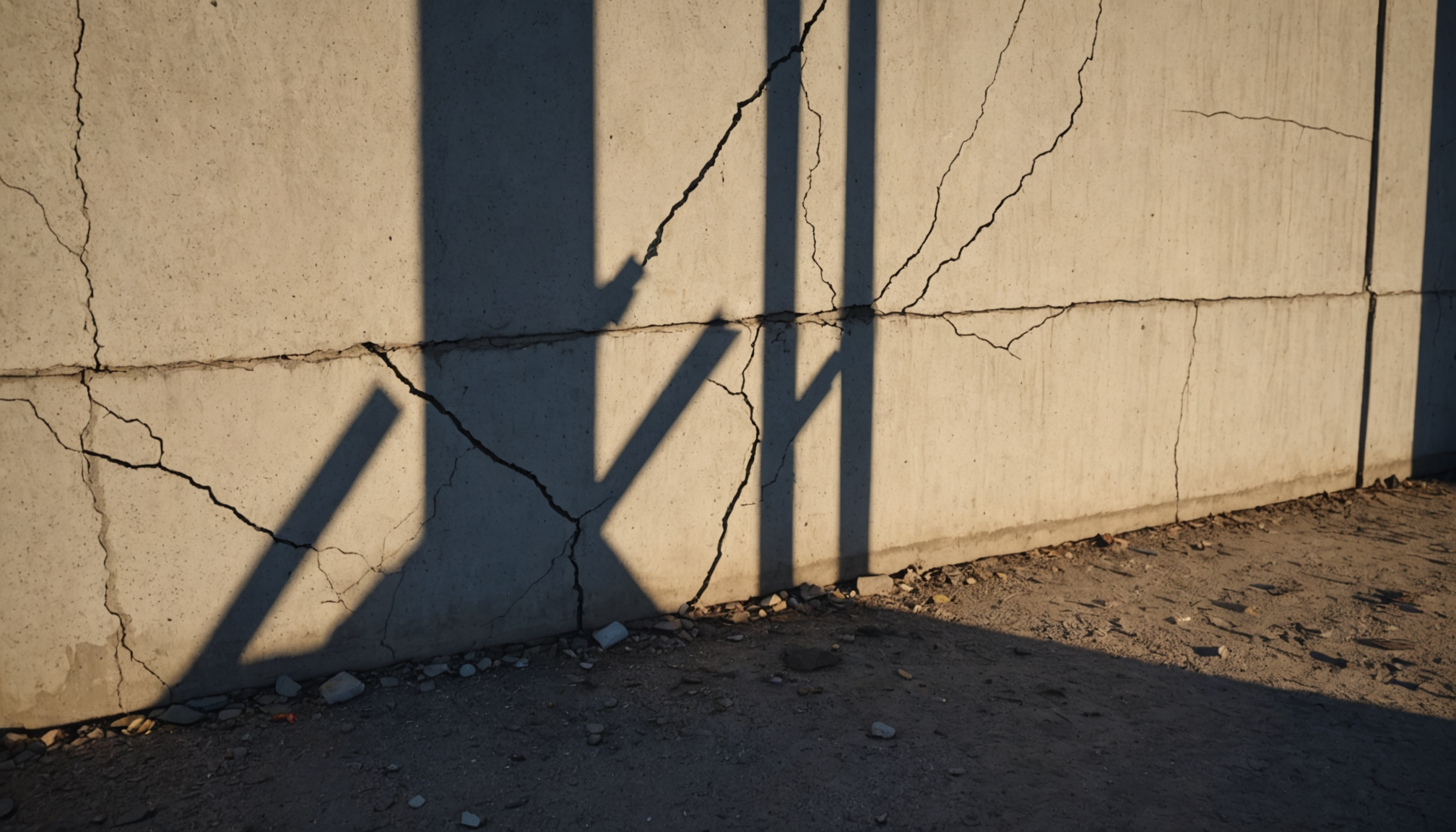In the realm of property inspections, structural issues often take precedence due to their potential impact on the integrity and safety of a building. These concerns can manifest in various ways, ranging from minor cosmetic cracks to significant foundational shifts that demand immediate attention. Understanding the signs and implications of structural issues is crucial for property owners, prospective buyers, and inspectors alike.
The foundational integrity of a building is paramount. Issues such as settling or subsidence can indicate deeper problems with the soil or construction methods. One common sign of foundational issues is cracking in the building’s foundation walls or floors. Not all cracks signify a critical problem, but horizontal cracks, or those wider than 1/4 inch, often warrant further investigation. Such cracks can suggest pressure being exerted on the foundation walls, usually due to water accumulation or soil issues.
Beyond the foundation, structural beams and supports must be closely examined. These components bear the load of the structure, and any signs of rot, sagging, or warping could compromise the building’s stability. Wooden beams are particularly susceptible to damage from moisture and pests, while metal supports might rust if exposed to the elements. Regular assessment and maintenance of these components can prevent minor issues from escalating into major safety hazards.
Load-bearing walls are another critical element in maintaining a building’s structural health. Any alterations or damages to these walls demand careful inspection. For instance, the removal of a load-bearing wall without proper support can lead to structural failure. Indicators of compromised load-bearing walls include doors and windows that stick or do not open and close smoothly, and cracks above doorways or windows.
To ensure a comprehensive understanding of potential structural issues, inspectors often employ both visual assessments and advanced diagnostic tools such as laser levels and moisture meters. These tools help in identifying problems that might not be immediately apparent to the naked eye.
Below is a comparison table listing common structural issues and their potential implications:
| Structural Issue | Potential Implication |
| Foundation cracks | Possible water intrusion and structural instability |
| Sagging beams | Increased risk of collapse |
| Rotting supports | Compromised structural integrity |
| Compromised load-bearing walls | Risk of structural shift or collapse |
Understanding the severity and implications of structural issues allows for informed decision-making about necessary repairs and preventative measures. Regular inspections are essential to maintaining the longevity and safety of any structure, allowing for timely identification and mitigation of potential problems.
electrical system defects
 Electrical systems are critical components of any building, ensuring a steady and reliable power supply to meet modern demands. However, defects within these systems are not uncommon and can range from minor nuisances to severe hazards, including fire risks. Identifying potential issues early during inspections can prevent costly repairs and dangerous situations.
Electrical systems are critical components of any building, ensuring a steady and reliable power supply to meet modern demands. However, defects within these systems are not uncommon and can range from minor nuisances to severe hazards, including fire risks. Identifying potential issues early during inspections can prevent costly repairs and dangerous situations.
One of the most common problems found is outdated wiring. Older buildings, in particular, may still be using knob-and-tube or aluminum wiring, both of which are considered safety hazards by today’s standards. Modern demands on electrical systems far exceed what was envisaged when these systems were first installed. Outdated wiring can lead to overloading, sparking, and even fires. Upgrading to modern wiring, such as copper, is recommended to handle the electrical load demanded by contemporary appliances and devices.
Improperly installed electrical components also pose a significant risk. Over the years, quick fixes and DIY repairs may lead to hazardous conditions. Common issues include:
- Connections: Ensure all electrical connections and splices are secure and insulated. Loose connections can cause short circuits and arcing, possibly resulting in fires.
- Outlets and Switches: Look for signs of damage or wear, such as scorch marks or buzzing sounds, which could indicate faulty wiring or poor connections.
- Breakers and Fuses: Frequently tripping breakers or blown fuses are indicative of an overloaded circuit or a short, both requiring immediate attention to prevent overheating.
Grounding issues are another critical concern. Proper grounding ensures excess electrical charge is safely dissipated into the ground, preventing electric shock or equipment damage. Inspectors should ensure all outlets, especially in wet areas like kitchens and bathrooms, have ground fault circuit interrupters (GFCIs) installed. These devices can cut off power almost immediately if a ground fault is detected, preventing potential electrocution.
Panels and circuit breakers require careful scrutiny during inspections. Inspectors need to ensure that electrical panels are not overly crowded or harbor mismatched breakers. Each breaker should appropriately match the circuit it protects, and there shouldn’t be any signs of corrosion or water damage within or around the panel.
Lighting fixtures, often overlooked during inspections, can also be sources of defect. Ensure that fixtures are properly installed and bulbs and fittings do not exceed the recommended wattage, which could lead to overheating.
To effectively address electrical system defects, a systematic inspection approach is essential:
- Review the electrical system’s age and inquire about past upgrades or repairs.
- Perform a visual inspection of visible wiring, outlets, switches, and fixtures for any signs of wear or damage.
- Test all GFCI and AFCI outlets and breakers for correct operation.
- Check the electrical panel for proper circuit labeling, secure connections, and absence of mismatched components or signs of overheating.
- Use electrical testers to measure the adequacy of power supply to outlets and ensure proper grounding.
Finding and resolving electrical system defects not only enhances the safety of the property but also ensures optimal functionality and compliance with current standards. Conducting thorough inspections and implementing regular maintenance checks to promptly address potential issues is vital in safeguarding both the building and its inhabitants.
plumbing concerns
 Plumbing concerns during inspections can reveal a host of potential issues that, if left unaddressed, may lead to costly repairs and significant inconvenience for property owners. Identifying these issues early on can save time, money, and hassle in the long run. Common plumbing problems encountered during inspections often include leaks, outdated piping materials, drainage blockages, and insufficient water pressure.
Plumbing concerns during inspections can reveal a host of potential issues that, if left unaddressed, may lead to costly repairs and significant inconvenience for property owners. Identifying these issues early on can save time, money, and hassle in the long run. Common plumbing problems encountered during inspections often include leaks, outdated piping materials, drainage blockages, and insufficient water pressure.
Leaks are one of the most prevalent problems in plumbing systems and can occur in various parts of a building, including pipes, faucets, and toilets. Even small leaks can lead to substantial water wastage over time, resulting in increased utility bills. More significantly, hidden leaks can cause structural damage, promote mold growth, and compromise indoor air quality. During inspections, signs of leaks might include water stains on walls or ceilings, warped or sagging floors, and a musty odor indicative of mold or mildew.
Outdated plumbing materials such as lead pipes or galvanized steel are also common red flags during inspections. Lead pipes, which were commonly used in older homes, pose significant health risks due to potential lead contamination in drinking water. Similarly, galvanized pipes are prone to corrosion and rust, leading to decreased water flow and the possibility of pipe failures. Modernizing these systems by replacing them with copper or PEX piping can greatly enhance both safety and efficiency.
Drainage issues, characterized by slow drains or frequent backups, are another concern that must be addressed. These problems are often caused by blockages due to debris buildup, tree root intrusion, or improperly aligned pipes. In severe cases, improper drainage can lead to sewage backups, posing serious health risks and requiring urgent attention. Inspectors often use specialized cameras to examine the condition of underground pipes and identify any blockages or damage.
Low water pressure is a frequent complaint that can result from various issues, including clogged pipes, faulty pressure regulators, or leaks. It not only affects daily activities like showering and dishwashing but may also indicate underlying problems within the plumbing system. Inspectors will measure water pressure and examine the infrastructure to determine the root cause of the issue.
By addressing plumbing concerns proactively, property owners can avoid significant water damage and ensure the health and safety of the building’s occupants. Regular plumbing inspections are not only an essential part of home maintenance but also crucial for preserving the value and functionality of the property. Through comprehensive assessments, inspectors can provide actionable insights and recommendations, empowering property owners to make informed decisions about repairs and upgrades. This vigilance ultimately helps maintain a safe and comfortable living environment, benefiting both current and future occupants.
HVAC inefficiencies
 Inspections often reveal inefficiencies within heating, ventilation, and air conditioning (HVAC) systems, which can lead to increased energy costs, discomfort, and even health issues. Identifying and addressing these inefficiencies is essential for maintaining optimal indoor air quality and ensuring the comfort of a building’s occupants.
Inspections often reveal inefficiencies within heating, ventilation, and air conditioning (HVAC) systems, which can lead to increased energy costs, discomfort, and even health issues. Identifying and addressing these inefficiencies is essential for maintaining optimal indoor air quality and ensuring the comfort of a building’s occupants.
One common issue is improper installation or maintenance of HVAC components. This can lead to reduced system efficiency and premature equipment failure. For example, poorly installed ductwork can result in significant air leakage, which forces the HVAC system to work harder to maintain desired temperatures, thereby increasing energy use and wear on equipment. Insulation deficiencies within ducts also contribute to energy waste and inefficiency. Inspections should carefully assess the state of duct connections and insulation, verifying that there are no visible gaps or damage.
Dirty or clogged filters present another frequent problem that impacts system performance. When filters are not regularly cleaned or replaced, airflow is restricted, causing the system to overwork and decreasing its lifespan. Moreover, clogged filters may lead to poor indoor air quality, potentially triggering allergies and respiratory issues among occupants. Regular maintenance schedules for replacing filters can prevent these issues and ensure the system runs efficiently.
Thermostat malfunctions or improper settings can also lead to inefficiencies. Many HVAC systems today are controlled by programmable or smart thermostats, which can yield substantial energy savings when utilized correctly. However, if such devices are malfunctioning or incorrectly programmed, they might cause the system to operate unnecessarily or at less-than-optimal times. Ensuring the thermostat is functioning properly and programming it to suit the occupants’ needs is a straightforward way to enhance efficiency.
Refrigerant leaks within air conditioning units represent another major concern. Such leaks not only reduce the cooling efficiency of the system but also pose environmental risks given the harmful effects of refrigerants like chlorofluorocarbons (CFCs) on the ozone layer. Inspections should include checks for refrigerant levels and tests for potential leaks, which, if found, should be promptly addressed by a qualified HVAC technician.
Additionally, aging or outdated HVAC equipment often lacks the efficiency of modern systems. Older units may not meet current efficiency standards and can significantly drive up energy costs. Upgrading to a newer, more efficient system can result in long-term savings and improved performance. During inspections, evaluating the age and condition of HVAC equipment can inform decisions about potential upgrades.
Addressing HVAC inefficiencies proactively can lead to enhanced comfort, reduced energy consumption, and improved air quality. Regular maintenance and inspections are key components in ensuring HVAC systems operate at peak efficiency, providing a sustainable environment that benefits both building owners and occupants. By focusing on these areas, property owners can make informed decisions regarding repairs, upgrades, and maintenance schedules, ultimately fostering a more efficient and comfortable indoor environment.
roofing and insulation problems
 Roofing and insulation problems are frequently encountered during property inspections and can have profound effects on a building’s energy efficiency, structural integrity, and occupant comfort. Addressing these issues promptly is essential to prevent costly repairs and ensure the long-term durability of the property.
Roofing and insulation problems are frequently encountered during property inspections and can have profound effects on a building’s energy efficiency, structural integrity, and occupant comfort. Addressing these issues promptly is essential to prevent costly repairs and ensure the long-term durability of the property.
One of the primary concerns in roofing is water damage resulting from leaks or inadequate drainage systems. Leaks can often go undetected for an extended period, leading to rot, mold, and eventual structural weakening. Inspectors should thoroughly check for signs of water intrusion such as stained ceilings, warped or buckled roofing materials, and mold growth. Furthermore, ensuring that gutters and downspouts are clean and free of debris is vital to prevent water back-up, which can lead to extensive roof and foundation damage.
Another issue that often arises during inspections is the condition of the roofing materials themselves. Over time, shingles or tiles can become damaged by wind, hail, or regular wear and tear, leading to missing or broken pieces. This not only compromises the roof’s ability to shed water effectively but also makes the property susceptible to pests and drafts. Inspectors will closely examine roofing surfaces for any damaged sections and assess whether repairs or replacements are necessary.
Insulation problems, while not immediately visible, significantly affect a home’s thermal efficiency and energy consumption. Insufficient or improperly installed insulation can allow unwanted heat exchange, making it difficult to maintain a consistent indoor temperature. During inspections, indicators of poor insulation include uneven temperatures throughout the house, high energy bills, and evidence of drafts. In attics and walls, damaged or missing insulation material should be replaced to improve the building envelope’s effectiveness.
Moreover, the presence of ventilation is crucial in both the roof and attic areas to mitigate moisture buildup and regulate temperature. Without proper ventilation, moisture can accumulate, resulting in mold growth and compromising insulation integrity. Inspectors should verify that there is adequate ventilation in place and that it is functioning properly to support the overall health of the roofing and insulation systems.
By identifying and rectifying roofing and insulation problems early, property owners can enhance their homes’ energy efficiency and structural resilience. Regular inspections and maintenance contribute to prolonging the life of these critical components, ensuring the safety and comfort of occupants while maintaining the property’s value.
In conclusion, addressing common problems found during inspections—from structural issues to HVAC inefficiencies—is essential for ensuring the safety, efficiency, and value of a property. Regular, comprehensive inspections offer invaluable insights into necessary repairs and upgrades, empowering property owners to maintain a safe, energy-efficient, and comfortable environment for all occupants.

